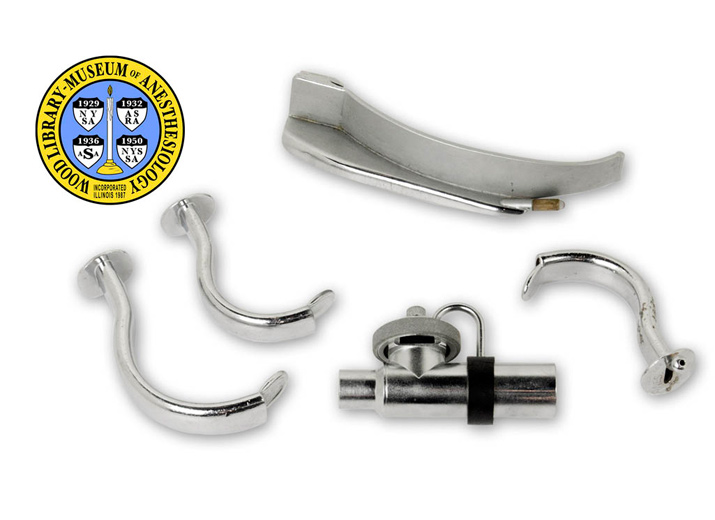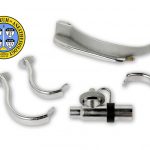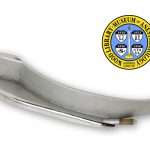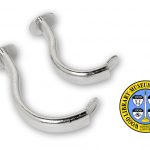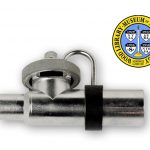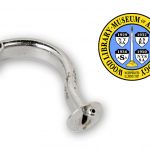Fink Collection
At the top of the photo is the Fink Laryngoscope Blade, and below it, from left to right, is a No. 5 Fink Vallecular Airway, a No. 3 Fink Vallecular Airway, the Fink Nonrebreathing Valve, and a No. 3 Fink Vallecular Airway with Nipple.
Intubation is the insertion of a plastic tube into a patient’s trachea (wind pipe) to maintain an open airway and assist breathing. Dr. B. Raymond Fink (1914-2000) designed his laryngoscope blade for use with difficult-to-intubate adults. A laryngoscope is an instrument used to view the larynx (voice box), which is the opening to the trachea and lungs. It consists of a “blade,” which goes into the patient’s mouth, and a handle. Fink’s blade is wider and has a shallower curve than the Macintosh Laryngoscope Blade.
A nonrebreathing valve prevents the patient from breathing air they have exhaled. The Fink Nonrebreathing Valve, described in the journal Anesthesiology in 1954, was the first nonrebreathing valve that allowed the anesthesiologist to provide assisted respirations with only one hand so that the opposite hand was free to attend to other responsibilities and patient needs.
Inspired by the function of the Macintosh Laryngoscope, Dr. Fink added a rounded extension to the end of his oral airways to reach the vallecula1 and indirectly raise the epiglottis2. Oral airways are placed over the tongue to create an air passage from the mouth to the far back of the throat. Fink recommended his oral airways for use with patients whose airways became obstructed during anesthesia despite the use of an oral airway. Airways with a ‘nipple’ were used to administer oxygen or sometimes a combination of oxygen and nitrous-oxide, or oxygen and halothane.
2. Epiglottis: a flap of tissue that covers the opening to the larynx (voice box).
Catalog Record: Fink Collection
Five Catalog Records (aips, aipv, aipt, aipr, aipu):
Access Key: aips
Accession No.: 2001-03-01-2 B
Title: Fink [laryngoscope blade / designed by B. Raymond Fink].
Author: Fink, B. Raymond (Bernard Raymond), 1914- 2000.
Title variation: Alt Title
Title: Fink blade.
Publisher: [Roslyn Heights, N.Y.] : Foregger, [1955-1980].
Physical Description: 1 laryngoscope blade : metal (stainless steel?, or aluminum and nickel plated brass?), brass, glass, copper ; 3 x 3 x 16 cm.
Subject: Laryngoscopes – curved blades.
Subject: Difficult Airway – management.
Note Type: Citation
Notes: Dorsch JA, Dorsch SE. Understanding Anesthesia Equipment: Construction, Care
and Complications. Baltimore: Williams & Wilkins, 1975:233.
Note Type: Citation
Notes: Epstein RM. ASA award: B. Raymond Fink. Anesthesiology. 1987;67(4):456-458.
Note Type: Citation
Notes: The Foregger Company, Inc. Catalog no. 15. Roslyn Heights, N.Y.: Foregger,
1958:130.
Note Type: Citation
Notes: Nique TA, Bennett CR, Altop H. Laryngoscope modification to avoid perioral
trauma due to laryngoscopy. Anesth Prog. 1982;29(2):47-49.
Note Type: Physical Description
Notes: This description is based on the perspective of an anesthesiologist holding
the blade with a handle for immediate use; The spatula of the blade has a
gentle curve, and is relatively wide: approx. 2.5 cm at the end proximal to
the handle and in the middle, and approx. 1.5 cm at the tip; If measured in a
straight line from the tip to the end of the fitting for the handle the blade
measures approx. 16 cm; If measured along the curve between the same two
points it measures approx. 18 cm; The flange on the lower left side is only 7
mm high in the middle and at the end closest to the tip; The outside of the
flange is hand engraved with the name, “Dr. F.P. Jones”; The distance between
the end of the light-bulb and the tip of the blade is only 3 cm; The
light-bulb is glass and brass[?]; Manufacture’s marks are on the fitting for
the handle:”FINK”, “PATENT PENDING”, and “FOREGGER”; A semicircular, copper,
electrical contact sits in a depression in the fitting.
Note Type: Reproduction
Notes: Photographed by Mr. William Lyle, July 28, 2010; Photographed with four other
anesthesia objects designed by Dr. Fink: 3 oral-airways and 1 Fink
nonrebreathing-valve.
Note Type: Acquisition
Notes: Donated in 2001 to the WLM by George S. Bause, M.D. in memory of B. Raymond
Fink, M.D.
Note Type: Historical
Notes: Dr. Fink was not only a clinician and innovator, he was also a very
productive researcher. His scholarly activities demonstrated a robust
intellect and expansive knowledge base. His research often occurred at the
intersection of multiple scientific disciples, such as pharmacology, anatomy,
physiology, and physics. Examples of insights resulting from Dr. Fink’s work
include the pharmacokinetics of diffusion anoxia, the discovery of the apneic
threshold, and advanced laryngeal physiology (Epstein, 1987). He wrote two
books on his developments in the understanding of the larynx: the first, The
Human Larynx: A Functional Study, and the second, Laryngeal Biomechanics. Dr.
Fink designed his blade for use with difficult to intubate adults, and it
came in only one size, size 4 (Nique, Bennett & Altop,1982 ; Dorsch & Dorsch,
1975). A 1958 Foregger catalog describes the blade as follows, “Macintosh
Laryngoscope Blade widened to improve balance and reduced in height to
protect the teeth. The recurved tip fits the vallecula, greatly facilitating
exposure in difficult cases. The forward light gives good illumination and
simplifies bulb replacement.”
Access Key: aipv
Accession No.: 2001-03-01-2 F
Title: Fink [vallecular airway] 5 / [designed by B. Raymond Fink].
Author: Fink, B. Raymond (Bernard Raymond), 1914- 2000.
Title variation: Alt Title
Title: Vallecular extension airway.
Title variation: Alt Title
Title: No. 5 Fink vallecular airway.
Publisher: [Roslyn Heights, N.Y.] : Foregger, [1957-1959].
Physical Description: 1 oropharyngeal airway : metal (nickel plated brass?) ; 7 x 3 x 10.5 cm.
Subject: Oropharyngeal Airway Devices.
Subject: Airway Management Equipment.
Note Type: General
Notes: Title based on Dr. Fink’s 1957 Anesthesiology [journal] article, and a 1958
Foregger Company catalog, as well as physical attributes; Alternate title
based on references to the airways in works written about Dr. Fink, including
Dr. Epstein’s 1987 Anesthesiology [journal] article and J. Roger Maltby’s
2002 book, Notable Names in Anaesthesia.
Note Type: Citation
Notes: Epstein RM. ASA award: B. Raymond Fink. Anesthesiology. 1987;67(4):456-458.
Note Type: Citation
Notes: Fink BR. Roentgenographic studies of the oropharyngeal airway. Anesthesiology
1957;15(5):711-718.
Note Type: Citation
Notes: The Foregger Company, Inc. Catalog no. 15. Roslyn Heights, N.Y.: Foregger,
1958:92.
Note Type: Citation
Notes: Maltby JR. Notable Names in Anaesthesia. London: Royal Society of Medicine
Press, 2002:63.
Note Type: Physical Description
Notes: This description is based on the perspective of an anesthesiologist holding
the airway for insertion (some might refer to this as upside-down); The
oropharyngeal airway is metal (nickel plated brass?) with a round flange;
Manufacturer’s markings on the flange include, “FOREGGER”, “FINK”, and “5”;
The opening to the central lumen, in the center of the flange, is the shape
of an oblate ellipsoid, approx. 1.9 cm wide and .5 cm high; A 2 mm hole is in
the side of the flange, to the left of the lumen opening; The body of the
airway is curved to fit the shape of the oropharyngeal space; The distance
from the flange to the opposite end of the airway when measured in a straight
line is approx. 10.5 cm; The distance between the flange and the end of the
extension when measured along the upper curve is approx. 15.6 cm; A
cross-section of the body of the airway would be the shape of an oblate
ellipsoid; The tip of the upper side of the airway has a rounded extension
approx. 1.7 cm long and 1.5 cm wide; The edges of the extension are rounded.
Note Type: Reproduction
Notes: Photographed by Mr. William Lyle, July 28, 2010; Photographed with four other
anesthesia objects designed by Dr. Fink: 2 other oral-airways, 1 Fink
laryngeal blade, and 1 Fink nonrebreathing-valve.
Note Type: Acquisition
Notes: Donated in 2001 to the WLM by George S. Bause, M.D. in memory of B. Raymond
Fink, M.D.
Note Type: Historical
Notes: Dr. Fink developed the vallecular extension airway in response to patients
who had supralaryngeal obstructions during anesthesia despite the use of an
oral airway (Fink, 1957). He wanted something that would support the tongue
without depressing the epiglottis (Fink, 1957). His solution was inspired by
the function of the Macintosh laryngoscope – specifically how it moves the
tongue forward and indirectly raises the epiglottis (Fink, 1957). In
discussing his study of the airway using x-ray images Dr. Fink concluded that
his vallecular airway was especially helpful for patients that have an
unusually large tongue or short neck (Fink, 1957). A 1958 Foregger Company
equipment catalog listed the airway for $6.00.
Access Key: aipt
Accession No.: 2001-03-01-2 D
Title: Fink [vallecular airway] : 3 / [designed by B. Raymond Fink].
Author: Fink, B. Raymond (Bernard Raymond), 1914- 2000.
Title variation: Alt Title
Title: Vallecular extension airway.
Title variation: Alt Title
Title: No. 3 Fink vallecular airway.
Publisher: [Roslyn Heights, N.Y.] : Foregger, [1957-1959].
Physical Description: 1 oropharyngeal airway : metal (nickel plated brass?) ; 5.5 x 3 x 8 cm.
Subject: Oropharyngeal Airway Devices.
Subject: Airway Management Equipment.
Note Type: General
Notes: Title from Dr. Fink’s 1957 Anesthesiology [journal] article, and a 1958
Foregger Company catalog; Alternate title based on references to the airways
in works written about Dr. Fink, including Dr. Epstein’s 1987 Anesthesiology
[journal] article and J. Roger Maltby’s 2002 book, Notable Names in
Anaesthesia.
Note Type: Citation
Notes: Epstein RM. ASA award: B. Raymond Fink. Anesthesiology. 1987;67(4):456-458.
Note Type: Citation
Notes: Fink BR. Roentgenographic studies of the oropharyngeal airway. Anesthesiology
1957;15(5):711-718.
Note Type: Citation
Notes: The Foregger Company, Inc. Catalog no. 15. Roslyn Heights, N.Y.: Foregger,
1958:92.
Note Type: Citation
Notes: Maltby JR. Notable Names in Anaesthesia. London: Royal Society of Medicine
Press, 2002:63.
Note Type: Physical Description
Notes: This description is based on the perspective of an anesthesiologist holding
the airway for insertion (some might refer to this as upside-down); The
oropharyngeal airway is metal (nickel plated brass?) with a circular flange;
Manufacturer’s markings on the flange include, “FOREGGER”, “FINK”, and “3”;
The opening to the central lumen, in the center of the flange, is the shape
of an oblate ellipsoid, approx. 1.7 cm wide and .5 cm high; A 2 mm hole is in
the side of the flange, to the left of the lumen opening; The body of the
airway is curved to fit the shape of the oropharyngeal space; The distance
from the flange to the opposite end of the airway when measured in a straight
line is approx. 8 cm; The distance between the flange and the end of the
extension when measured along the upper curve is approx. 10.7 cm; A
cross-section of the body of the airway would be oblate ellipsoid in shape;
The tip of the upper side of the airway has a rounded extension approx. 1.5
cm long and 1.4 cm wide; The edges of the extension are rounded.
Note Type: Reproduction
Notes: Photographed by Mr. William Lyle, July 28, 2010; Photographed with four other
anesthesia objects designed by Dr. Fink: 2 other oral-airways, 1 Fink
laryngeal blade, and 1 Fink nonrebreathing-valve.
Note Type: Acquisition
Notes: Donated in 2001 to the WLM by George S. Bause, M.D. in memory of B. Raymond
Fink, M.D.
Access Key: aipr
Accession No.: 2001-3-1-2 A
Title: [ Fink nonrebreathing valve / designed by Bernard Raymond Fink.]
Author: Fink, B. Raymond (Bernard Raymond), 1914- 2000.
Title variation: Alt Title
Title: Fink inflating valve.
Title variation: Alt Title
Title: Fink’s non-rebreathing valve.
Title variation: Alt Title
Title: Fink modification of the Slater-Stephen valve.
Publisher: [Madison, Wis. : Ohio Chemical Co., 1953-1980.]
Physical Description: 1 nonrebreathing valve : metal (stainless steel? or nickel plated brass?), aluminum,, rubber ; 5.5 x 4 x 9.5 cm.
Subject: Nonrebreathing Valves.
Subject: Anesthesia, Pediatric.
Note Type: General
Notes: Title from a September 1954 Anesthesiology [journal] article by Dr. Fink
where he describes the valve; Alternate titles from WLM name from the object,
and Ohio Medical Products catalogs.
Note Type: Citation
Notes: Dorsch JA, Dorsch SE. Understanding Anesthesia Equipment: Construction, Care
and Complications. Baltimore: Williams & Wilkins, 1975:177-178.
Note Type: Citation
Notes: Fink BR. A nonrebreathing valve of new design. Anesthesiology.
1954;15(5):471-474.
Note Type: Citation
Notes: Maltby JR. Notable Names in Anaesthesia. London: Royal Society of Medicine
Press, 2002:63.
Note Type: Physical Description
Notes: The valve body is tubular, or cylindrical, with one narrower (1.5 cm opening
vs. 2.5 cm) end; The wider opening is the inlet side of the valve; The
narrower opening is the outlet; A 4 cm dia. metal housing for a diaphragm and
disk is joined to the body of the valve near the outlet; An adjustable knob
sits at the top of the diaphragm and disk housing; A thin, curved metal duct,
or pressure tube, connects the inlet side of the valve to the top of the
housing for the diaphragm and disk; A black rubber ring wraps around the body
of the valve where the duct enters it; Inside the body of the valve, just
below the housing for the diaphragm and disk, is a black rubber
nonrebreathing-valve; When there is positive pressure from the reservoir-bag,
the diaphragm and disk seal off the expiratory valve; When pressure is
released from the bag the exhalation valve works normally.
Note Type: Reproduction
Notes: Photographed by Mr. William Lyle, July 28, 2010; Photographed with four other
anesthesia objects designed by Dr. Fink: 3 oral-airways and 1 laryngoscope
blade.
Note Type: Acquisition
Notes: Donated in 2001 to the WLM by George S. Bause, M.D. in memory of B. Raymond
Fink, M.D.
Note Type: Historical
Notes: Dr. Fink designed the nonrebreathing valve within a year of completing his
anesthesia residency and joining the staff of Presbyterian Hospital in New
York (Maltby, 2002). Before 1953, anesthesiologists had to use both hands in
order to provided assisted respirations: one hand squeezed the reservoir bag
while the other occluded the valve’s expiratory opening. Dr. Fink’s
nonrebreathing valve was his response to this limitation (Fink, 1954). It was
the first nonrebreathing valve that allowed the anesthesiologist to provide
assisted respirations with one hand free to address other responsibilities
and patient needs (Maltby, 2002). In addition to the straight valve, Ohio
also manufactured a right-angle Fink nonrebreathing valve for use with
Heidbrink socket-type masks. Jerry Dorsch and Susan Dorsch provide a detailed
description of the valve’s construction and function in their 1975 text
Understanding Anesthesia Equipment.
Access Key: aipu
Accession No.: 2001-03-01-2 E
Title: Fink [vallecular airway] : 3 [with nipple / designed by B. Raymond Fink].
Author: Fink, B. Raymond (Bernard Raymond), 1914- 2000.
Title variation: Alt Title
Title: Vallecular extension airway with nipple.
Title variation: Alt Title
Title: No. 3 Fink vallecular airway with nipple.
Publisher: [Roslyn Heights, N.Y.] : Foregger, [1957-1959].
Physical Description: 1 oropharyngeal airway : metal (nickel plated brass?) ; 5.5 x 3.5 x 8 cm.
Subject: Oropharyngeal Airway Devices.
Subject: Airway Management Equipment.
Subject: Insufflation.
Subject: Anesthesia, Inhalation.
Subject: Oxygen.
Subject: Nitrous Oxide.
Subject: Halothane.
Note Type: General
Notes: Title based on Dr. Fink’s 1957 Anesthesiology [journal] article, and a 1958
Foregger Company catalog, as well as physical attributes; Alternate title
based on references to the airways in works written about Dr. Fink, including
Dr. Epstein’s 1987 Anesthesiology [journal] article and J. Roger Maltby’s
2002 book, Notable Names in Anaesthesia.
Note Type: Citation
Notes: Epstein RM. ASA award: B. Raymond Fink. Anesthesiology. 1987;67(4):456-458.
Note Type: Citation
Notes: Fink BR. Roentgenographic studies of the oropharyngeal airway. Anesthesiology
1957;15(5):711-718.
Note Type: Citation
Notes: The Foregger Company, Inc. Catalog no. 15. Roslyn Heights, N.Y.: Foregger,
1958:92.
Note Type: Citation
Notes: Maltby JR. Notable Names in Anaesthesia. London: Royal Society of Medicine
Press, 2002:63.
Note Type: Physical Description
Notes: This description is based on the perspective of an anesthesiologist holding
the airway for insertion (some might refer to this as upside-down); The
oropharyngeal airway is metal (nickel plated brass?) with a circular flange;
Some of the nickel is worn away exposing brass underneath; Manufacturer’s
markings on the flange include, “FOREGGER”, “FINK”, and “3”; There are also
hand engraved marks: [above the lumen opening] “ANES F.O.R.” [below the lumen
opening] “1-58”; The opening to the central lumen, in the center of the
flange, is the shape of an oblate ellipsoid, approx. 1.7 cm wide and .5 cm
high; A 2 mm hole is in the side of the flange, to the left of the lumen
opening; The nipple exits the lumen opening on the right side, is approx 1 cm
in length, and ends in a spherical shape (approx. 7 mm in dia.) with its
lumen opening at the very tip; The body of the airway is curved to fit the
shape of the oropharyngeal space; The distance from the flange to the
opposite end of the airway when measured in a straight line is approx. 8 cm;
The distance between the flange and the end of the extension when measured
along the upper curve is approx. 10.7 cm; A cross-section of the body of the
airway would be the shape of an oblate ellipsoid; The tip of the upper side
of the airway has a rounded extension approx. 1.5 cm long and 1.4 cm wide;
The edges of the extension are rounded.
Note Type: Reproduction
Notes: Photographed by Mr. William Lyle, July 28, 2010; Photographed with four other
anesthesia objects designed by Dr. Fink: 2 other oral-airways, 1 Fink
laryngeal blade, and 1 Fink nonrebreathing-valve.
Note Type: Acquisition
Notes: Donated in 2001 to the WLM by George S. Bause, M.D. in memory of B. Raymond
Fink, M.D.
Note Type: Historical
Notes: Dr. Fink developed the vallecular extension airway in response to patients
who had supralaryngeal obstructions during anesthesia despite the use of an
oral airway (Fink, 1957). He wanted something that would support the tongue
without depressing the epiglottis (Fink, 1957). His solution was inspired by
the function of the Macintosh laryngoscope – specifically how it moves the
tongue forward and indirectly raises the epiglottis (Fink, 1957). In
discussing his study of the airway using x-ray images Dr. Fink concluded that
his vallecular airway was especially helpful for patients that have an
unusually large tongue or short neck (Fink, 1957). A 1958 Foregger Company
equipment catalog listed the Fink Vallecular Airway with an “insufflation
nipple” for $7.00. The airway without the nipple was listed for $6.00. The
nipple was used to administer oxygen or sometimes a combination of oxygen and
nitrous-oxide, or oxygen and halothane for insufflation anesthesia.


